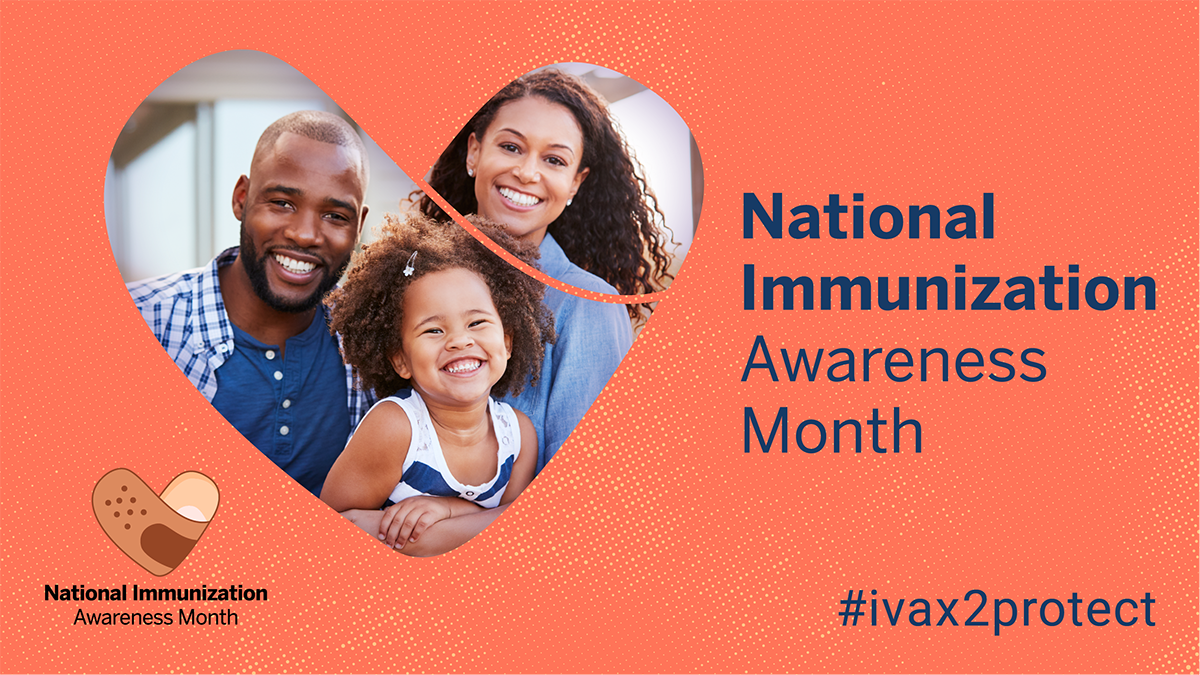August is National Immunization Awareness Month, so it’s a perfect time to highlight the importance of new and routine vaccinations for people of all ages.
WHAT ARE THE TYPES OF VACCINES?

There are several types of vaccines. They are:
- Live-attenuated vaccines – use a weakened form of the germ. Examples would be the MMR and Varicella (chickenpox) vaccines.
- Inactivated vaccines – use a killed version of the germ. The yearly Influenza shot would be an example, along with Polio and Rabies.
- Subunit, recombinant, polysaccharide, and conjugate vaccines – use only specific pieces of the germ. Examples would include Whooping Cough, Shingles, Pneumonia and Hepatitis B.
- Toxoid vaccines – that use a toxin (harmful product) made by the germ. Examples would be Tetanus and Diphtheria.
- mRNA vaccines – use messenger RNA, which gives your cells instructions for how to make a protein or piece of the protein of the germ. This is a new methodology and is how the COVID-19 was developed.
- Viral vector vaccines – use genetic material, which gives your cells instructions for making a protein of the germ. These vaccines also contain a different, harmless virus that helps get the genetic material into your cells.
HOW DO VACCINES WORK?
Vaccines work in different ways, but they all spark an immune response.
Every exposure of the “germ” or a part of it will teach your immunity to respond. This response can be either from the virus itself with an exposure, or from a vaccine. In other words, these exposures spark and rev up your immunity engine, and makes it ready to blast off to attack the foreign viruses that wants to invade your body.
Each individual response to the exposure is different and can be hard to measure. Individuals that have a weakened or compromised immune system will not respond to the vaccines as well. Examples would be individuals that have had cancer or chemotherapy, organ transplants, chronic diseases, HIV infections or AIDS and the age of the individuals.
HOW DO VIRUSES MUTATE?
Viruses rely on a host to survive and replicate. They invade the body of a human or an animal and bind with the host’s cells to allow their own genetic material (RNA) to enter the cells. The host’s own cells read the genetic code and replicates it, making more of the virus. That new virus then leaves the cell in search of another host to infest. Sometimes when that genetic code is being translated in a host, a piece of the code gets changed. This is called a mutation, and they happen frequently. So, anytime that the virus gets to infest a new host, it has a chance to mutate. The more times it infects another host, the more times it has a chance to mutate. The manufacturers of the vaccines are studying the efficacy of vaccines to these mutations and developing a plan for booster vaccines.
WHO SHOULD GET VACCINATED?
Receiving the proper vaccinations not only protects you, but it also protects the people around you, especially those with a compromised immune system and those who are not able to be vaccinated. The national goal for vaccinations for COVID-19 is 70%. This threshold would give enough individuals in the community immunity so that the virus will not be spread as easily.
According to the Minnesota Department of Health website, as of 8/12/21:
Cottonwood Co. 61% of 16 and older received COVID-19 vaccines
State wide 70.5% of 16 and older received COVID-19 vaccines
Many students will be heading back to school. Students that are together on buses, classrooms, or living in close quarters are particularity vulnerable to outbreaks to diseases. Many districts and institutions follow the CDC guidelines and requirements for their students. Contact them if there are any questions.
WHERE SHOULD YOU GO TO GET VACCINATED?
Many pharmacies and clinics are able to help you get you up to date on many of your immunizations. Contact them for further information. Also, the Minnesota Department of Health website has a COVID-19 hotline that you can call (833) 431-2053. COVID-19 vaccine locations are also available at www.health.state.mn.us.
By Jill Liepold, MT
Medical Laboratory Technician at Windom Area Health Laboratory Services
References:
www.osfhealthcare.org
www.health.state.mn.us
www.hhs.gov/immunization
